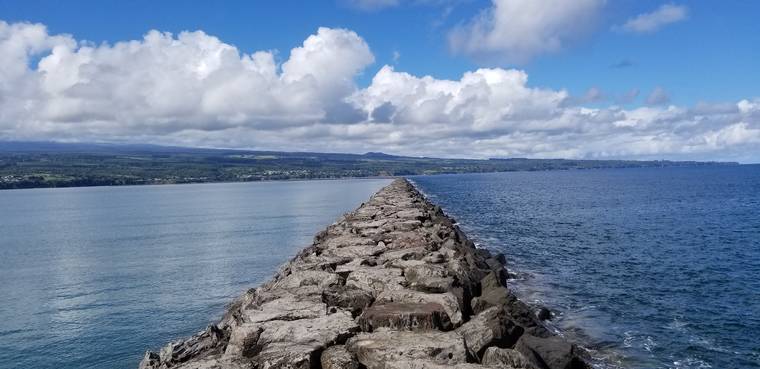The Hawaii County Council will vote next week whether to approve a state and federal study of potential modifications to the Hilo Bay breakwater.
A study about how to improve the aging breakwater has been discussed for more than a decade, but the issue was resurrected last year when Mayor Harry Kim raised the topic with the state Department of Transportation.
At Wednesday’s meeting of the County Council, council members will vote on a resolution that authorizes Kim to enter into agreements with the DOT’s Harbors Division and the U.S. Army Corps of Engineers to assist with the study.
If the council approves the resolution, the study will go forward as soon as all three parties — the county, the state and the Corps — can sign agreements and present the necessary money, said Derek Chow, deputy director for the DOT’s Harbors Division.
The study will cost $100,000, with the county and state each contributing $25,000 and the Corps of Engineers contributing the remainder.
Chow said the state already has its share of the funding lined up, and the Corps of Engineers’ share should already be approved as well, although appropriating federal funds might take some extra time.
The breakwater, which was built between 1908 and 1930 to shield ships in the bay from rough waves, has been blamed for trapping contaminants from the Wailuku and Wailoa rivers in the bay, leading to poor water quality.
A 2009 study suggested that opening a breach in the breakwater could improve water circulation within the bay, but that study was only a qualitative one capable of providing a yes or no answer for a single option. The upcoming study will be a quantitative one, Chow said, looking at several options for improving the bay’s circulation and determining which is the best choice.
“From all that we know, just improving water circulation may not be sufficient,” Chow said. “So we’ll be looking into other factors such as sediment transport and preventing junk from entering the ecosystem.”
One other possible option could be introducing organisms such as oysters that feed on particulates and assimilate the non-nutritional particles into their shells.
Kim said the project has been long delayed, but improving the quality of the bay has been a goal of his ever since his first stint in office in the early 2000s.
“Wouldn’t it be great if we could see that happen in our lifetimes?” he said.
Email Michael Brestovansky at mbrestovansky@hawaiitribune-herald.com.






